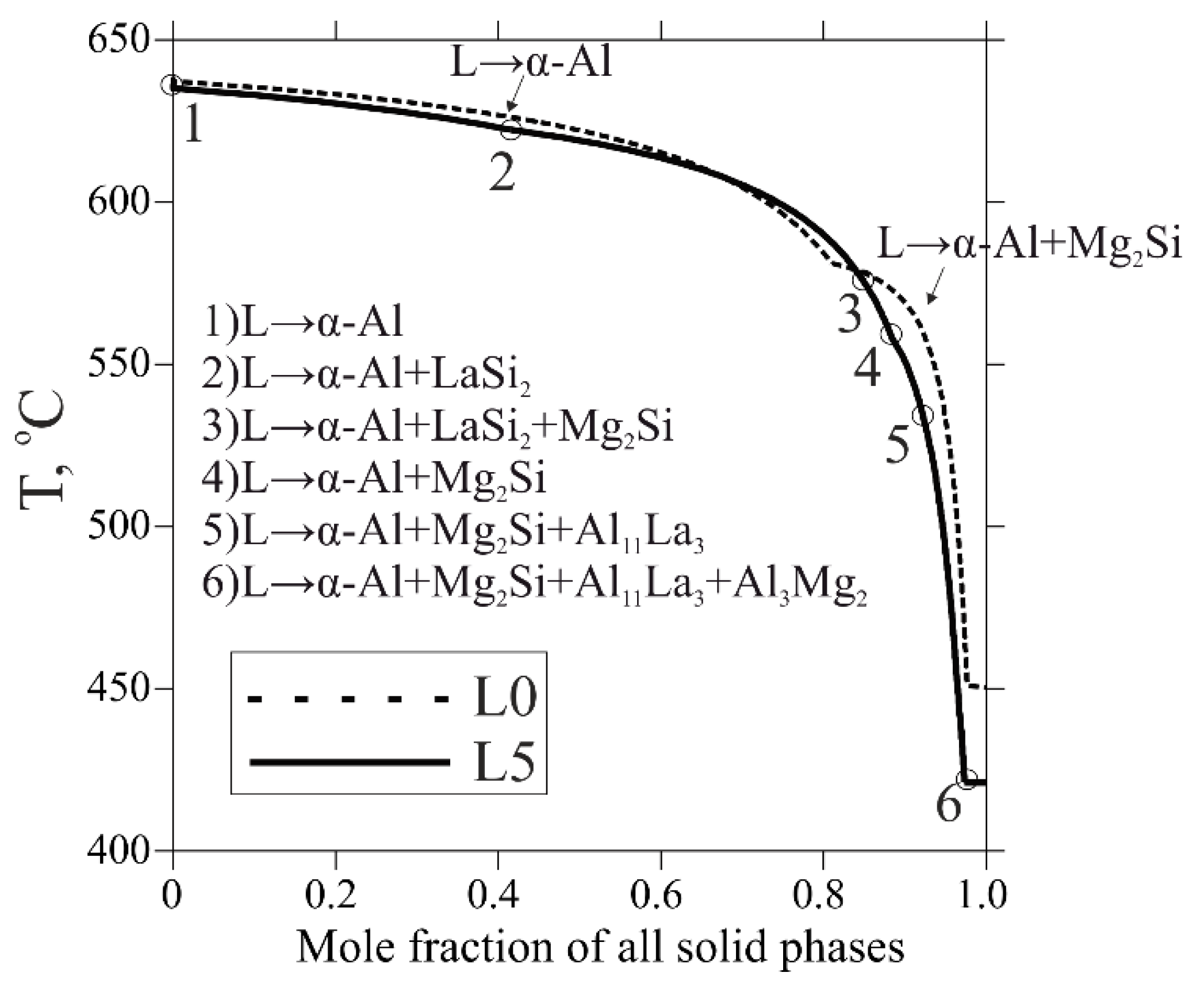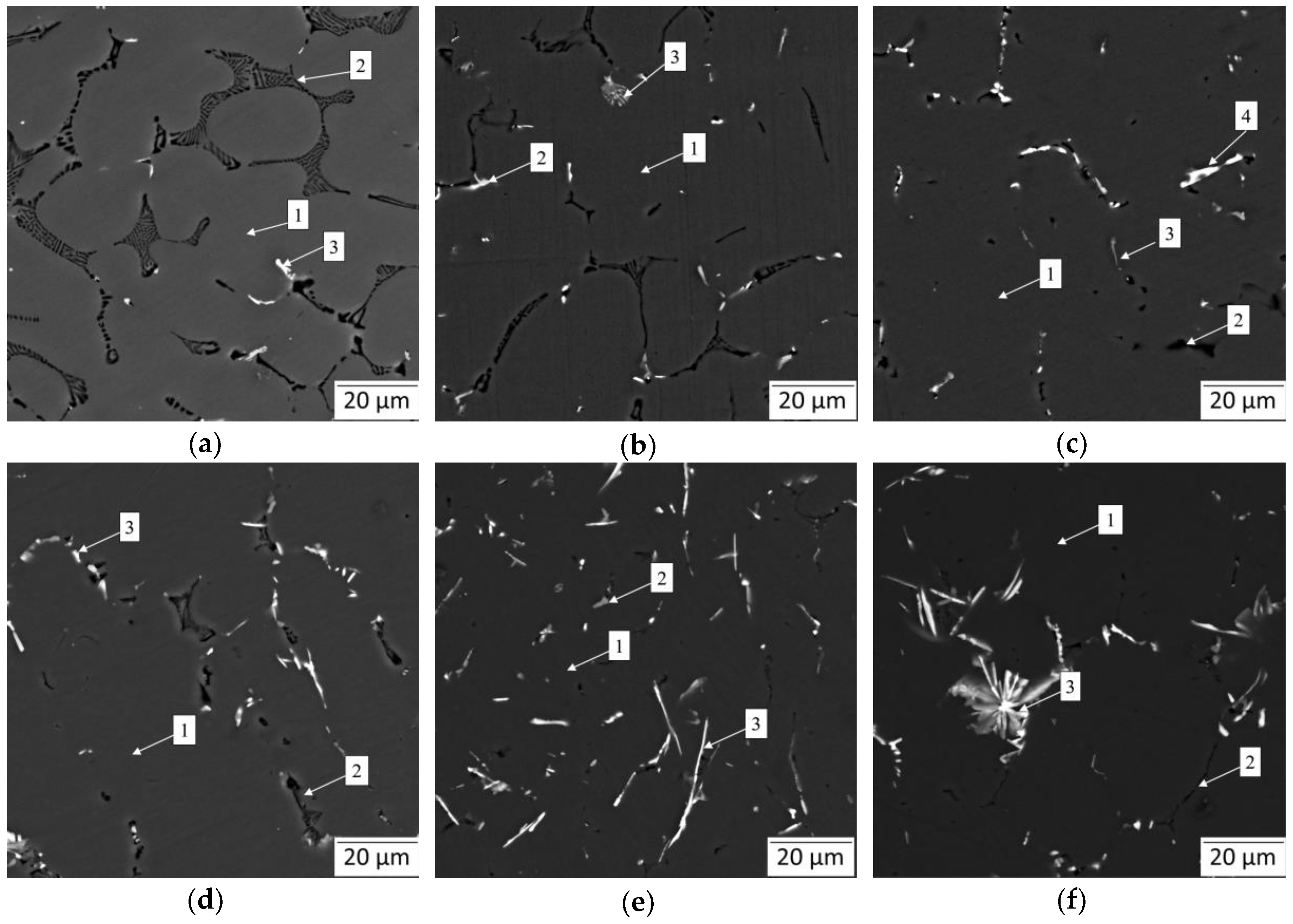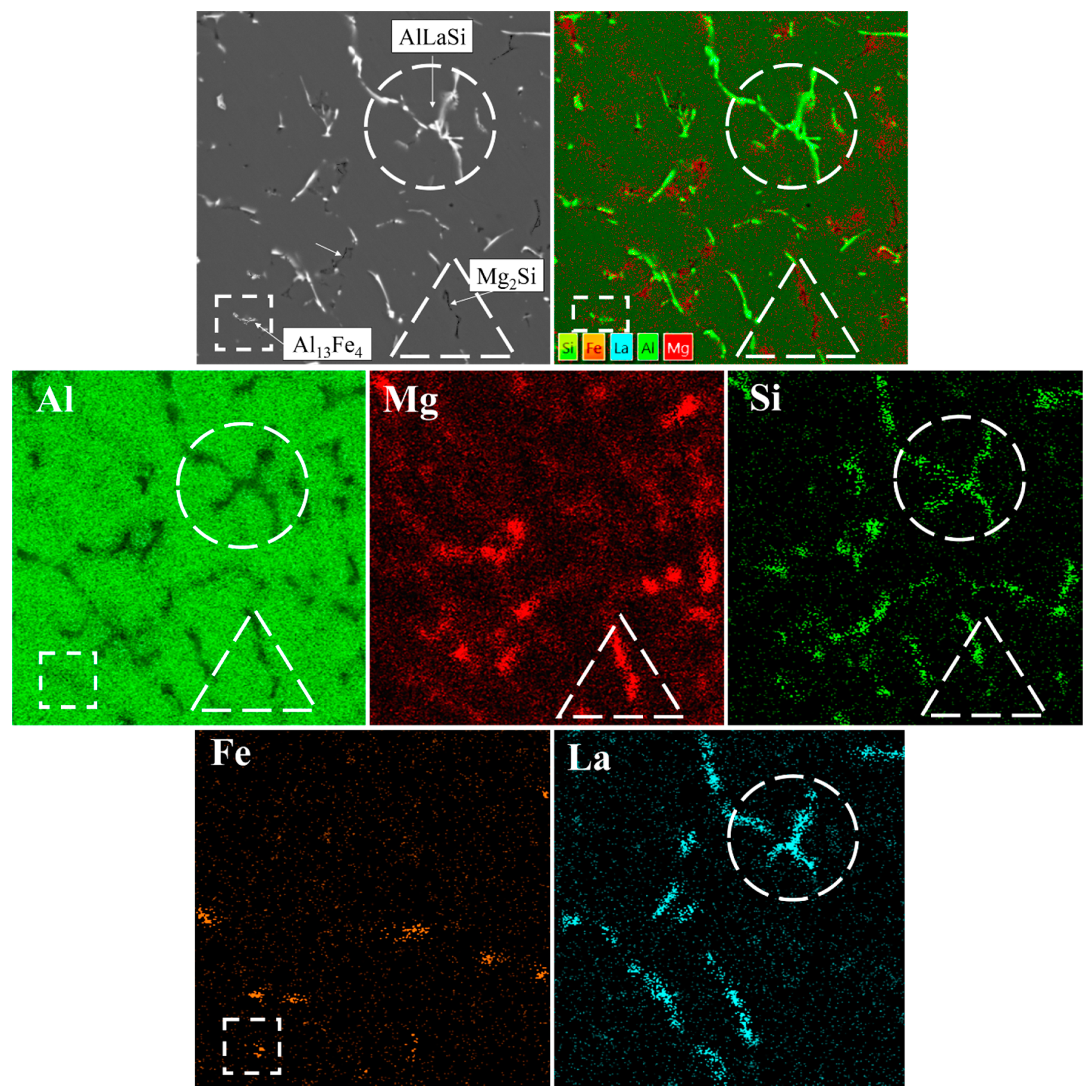Effect of La Addition on Solidification Behavior and Phase Composition of Cast Al-Mg-Si Alloy
Abstract
:1. Introduction
2. Materials and Methods
3. Results and Discussion
3.1. Thermodynamic Prediction
3.2. Microstructural Evolution
4. Discussion
5. Conclusions
- (1)
- Thermodynamic prediction using the CalPhaD approach is limited due to the lack of optimized databases resulting in the formation of only binary Mg2Si, LaSi2, Al11La3, and Al3Mg2 intermetallics of eutectic origin. However, the tendency toward change in intermetallics fraction and critical temperature may be considered as reliable. The addition of La causes an increase in LaSi2 along with a sharp decrease in the Mg2Si phase at the temperature under solidus. Moreover, the calculated equilibrium solidification ranges of the experimental alloys are near 55 °C that is increased fourfold in non-equilibrium conditions based on calculations using the Scheil–Gulliver model.
- (2)
- In contradiction to calculation, the microstructures of the La-containing alloys exhibited dominating ternary AlLaSi phase that is likely to be Al2LaSi2 compound. An increase in La content leads to the growth of the ternary phase. This growth is particularly enormous at over 0.5 wt.% La when the intermetallics evolved as slender needles (at 0.75 wt.% La) and stars (at 1 wt.% La).
- (3)
- A remarkable modifying effect of La on the eutectic Mg2Si phase was observed. The latter’s shape changed slightly after the addition of 0.1 wt.% La but evolved incredibly at a higher concentration from the lamellar down to slender flakes. This effect was referred to as adsorption of AlLaSi (Al2LaSi2) phase in the solid/liquid interface inhibiting the growth of the Mg2Si.
Author Contributions
Funding
Acknowledgments
Conflicts of Interest
References
- Gursoy, O.; Timelli, G. Lanthanides: A focused review of eutectic modification in hypoeutectic Al–Si alloys. J. Mater. Res. Tech. 2020, 9, 8652–8666. [Google Scholar] [CrossRef]
- De Giovanni, M.; Kaduk, J.A.; Srirangam, P. Modification of Al–Si Alloys by Ce or Ce with Sr. JOM 2019, 71, 426–434. [Google Scholar] [CrossRef] [Green Version]
- Abdelaziz, M.H.; Samuel, A.M.; Doty, H.W.; Valtierra, S.; Samuel, F.H. Effect of additives on the microstructure and tensile properties of Al–Si alloys. J. Mater. Res. Technol. 2019, 8, 2255–2268. [Google Scholar] [CrossRef]
- Lin, G.; Li, K.; Feng, D.; Feng, Y.; Song, W.; Xiao, M. Effects of La–Ce addition on microstructure and mechanical properties of Al–18Si–4Cu–0.5Mg alloy. Trans. Nonferr. Met. Soc. China 2019, 29, 1592–1600. [Google Scholar] [CrossRef]
- Jiang, H.; Li, S.; Zheng, Q.; Zhang, L.; He, J.; Song, Y.; Deng, C.; Zhao, J. Effect of minor lanthanum on the microstructures, tensile and electrical properties of Al-Fe alloys. Mater. Des. 2020, 195, 108991. [Google Scholar] [CrossRef]
- Balaram, V. Rare earth elements: A review of applications, occurrence, exploration, analysis, recycling, and environmental impact. Geosci. Front. 2019, 10, 1285–1303. [Google Scholar] [CrossRef]
- Cao, Z.; Kong, G.; Che, C.; Wang, Y.; Peng, H. Experimental investigation of eutectic point in Al-rich Al-La, Al-Ce, Al-Pr and Al-Nd systems. J. Rare Earths 2017, 35, 1022–1028. [Google Scholar] [CrossRef]
- Akopyan, T.K.; Belov, N.A.; Naumova, E.A.; Letyagin, N.V. New in-situ Al matrix composites based on Al-Ni-La eutectic. Mater. Lett. 2019, 245, 110–113. [Google Scholar] [CrossRef]
- Akopyan, T.K.; Letyagin, N.V.; Sviridova, T.A.; Korotkova, N.O.; Prosviryakov, A.S. New casting alloys based on the Al + Al4 (Ca,La) eutectic. JOM 2020. [Google Scholar] [CrossRef]
- Weiss, D. Improved High-Temperature Aluminum Alloys Containing Cerium. J. Mater. Eng. Perform. 2019, 28, 1903–1908. [Google Scholar] [CrossRef]
- Czerwinski, F. Cerium in aluminum alloys. J. Mater. Sci. 2020, 55, 24–72. [Google Scholar] [CrossRef]
- Yu, X.; Sun, J.; Li, Z.; Dai, H.; Fang, H.; Zhao, J.; Yin, D. Solidification behaviour and elimination of undissolved Al2CuMg phase during homogenization in Ce-modified Al–Zn–Mg–Cu alloy. Rare Met. 2020, 39, 1279–1287. [Google Scholar] [CrossRef]
- Hosseinifar, M.; Malakhov, D.V. Effect of Ce and La on microstructure and properties of a 6xxx series type aluminum alloy. J. Mater. Sci. 2008, 43, 7157–7164. [Google Scholar] [CrossRef]
- Mahmoud, M.G.; Elgallad, E.M.; Ibrahim, M.F.; Samuel, F.H. Effect of rare earth metals on porosity formation in A356 alloy. Int. J. Metalcast. 2018, 12, 251–265. Available online: http://dx.doi.org/10.1007/s40962-017-0156-5 (accessed on 3 November 2020). [CrossRef]
- Chen, Y.; Pan, Y.; Lu, T.; Tao, S.; Wu, J. Effects of combinative addition of lanthanum and boron on grain refinement of Al–Si casting alloys. Mater. Des. 2014, 64, 423–426. [Google Scholar] [CrossRef]
- Yao, D.; Xia, Y.; Qiu, F.; Jiang, Q. Effects of La addition on the elevated temperature properties of the casting Al–Cu alloy. Mater. Sci. Eng. A 2011, 528, 1463–1466. [Google Scholar] [CrossRef]
- Liping, W.; Erjun, G.; Baoxia, M. Modification effect of lanthanum on primary phase Mg2Si in Mg-Si alloys. J. Rare Earths 2008, 26, 105–109. [Google Scholar] [CrossRef]
- Bai, G.; Liu, Z.; Lin, J.; Yu, Z.; Hue, Y.; Wen, C. Effects of the addition of lanthanum and ultrasonic stirring on the microstructure and mechanical properties of the in situ Mg2Si/Al composites. Mater. Des. 2016, 90, 424–432. [Google Scholar] [CrossRef]
- Yao, D.; Qiu, F.; Jiang, Q.; Li, Y.; Arnberg, L. Effect of Lanthanum on grain refinement of casting aluminum-copper alloy. Int. J. Metalcast. 2013, 7, 49–54. [Google Scholar] [CrossRef]
- Pramod, S.L.; Bakshi, S.R.; Murty, B.S. Aluminum-Based Cast In Situ Composites: A Review. J. Mater. Eng. Perform. 2015, 24, 2185–2207. [Google Scholar] [CrossRef]
- Sun, Y.; Ahlatci, H. Mechanical and wear behaviors of Al-12Si-XMg composites reinforced with in situ Mg2Si particles. Mater. Des. 2011, 32, 2983–2987. [Google Scholar] [CrossRef]
- Prusov, E.; Deev, V.; Rakhuba, E. Aluminum Matrix In-Situ Composites Reinforced with Mg2Si and Al3Ti. Mater. Today Proc. 2019, 11, 386–391. [Google Scholar] [CrossRef]
- Glazoff, M.; Khvan, A.; Zolotorevsky, V.; Belov, N.; Dinsdale, A. Casting Aluminium Alloys: Their Physical and Mechanical Metallurgy, 2nd ed.; Elsevier: Amsterdam, The Netherlands, 2018. [Google Scholar] [CrossRef]
- Thermo-Calc Software TCAL4—TCS Al-Based Alloy Database, version 4.0; Thermo-Calc Software AB: Stockholm, Sweden, 2015; Available online: http://www.thermocalc.com (accessed on 15 October 2020).
- Hosseinifar, M.; Malakhov, D.V. The sequence of intermetallics formation during the solidification of an Al-Mg-Si alloy containing La. Metall. Mater. Trans. A 2011, 42, 825–833. [Google Scholar] [CrossRef]
- Du, J.; Tu, H.; Peng, H.; Liu, Y.; Wu, C.; Wang, J.; Su, X. Phase equilibria of the Al-Si-La system between 0 and 50 at.% La at 600 and 800 °C. JALCOM 2018, 765, 608–615. [Google Scholar] [CrossRef]
- Liu, Y.L.; Kang, S.B. Solidification and segregation of Al-Mg alloys and influence of alloy composition and cooling rate. Mater. Sci. Technol. 1997, 13, 331–336. [Google Scholar] [CrossRef]
- Liu, Y.; Luo, L.; Han, C.; Ou, L.; Wang, J.; Liu, C. Effect of Fe, Si and cooling rate on the formation of Fe- and Mn-rich intermetallics in Al–5Mg–0.8Mn alloy. J. Mater. Sci. Technol. 2016, 32, 305–312. [Google Scholar] [CrossRef]
- Liu, Y.L.; Kang, S.B. The solidification process of Al–Mg–Si alloys. J. Mater. Sci. 1997, 32, 1443–1447. [Google Scholar] [CrossRef]
- Thermo-Calc Software TCAL7—TCS Al-Based Alloy Database, version 4.0; Thermo-Calc Software AB: Stockholm, Sweden, 2020; Available online: http://www.thermocalc.com (accessed on 15 October 2020).
- Wong, C.; Styles, M.J.; Zhu, S.; Qiu, D.; McDonald, S.D.; Zhu, Y.; Gibson, M.A.; Abbott, T.B.; Easton, M.A. (Al,Mg)3La: A new phase in the Mg–Al–La system. Acta Cryst. 2018, B74, 370–375. [Google Scholar] [CrossRef] [Green Version]
- Gröbner, J.; Kevorkov, D.; Schmid-Fetzer, R. Thermodynamic modelling of Al–Ce–Mg phase equilibria coupled with key experiments. Intermetallics 2002, 10, 415–422. [Google Scholar] [CrossRef]
- Zhang, X.; Wang, Z.; Zhou, Z.; Xu, J. Influence of rare earth (Ce and La) addition on the performance of Al-3.0 wt%Mg alloy. J. Wuhan Univ. Technol.-Mater. Sci. Ed. 2017, 32, 611–618. [Google Scholar] [CrossRef]
- Wang, M.; Xu, W.; Han, Q. Study of Refinement and Morphology Change of AlFeSi Phase in A380 Alloy due to Addition of Ca, Sr/Ca, Mn and Mn, Sr. Mater. Trans. 2016, 57, 1509–1513. [Google Scholar] [CrossRef] [Green Version]
- Wu, X.; Zhang, H.; Jiang, H.; Mi, Z.; Zhang, H. Multi-Refinement Effect of Rare Earth Lanthanum on α-Al and Eutectic Si Phase in Hypoeutectic Al-7Si Alloy. Metals 2020, 10, 621. [Google Scholar] [CrossRef]
- Belov, N.A.; Naumova, E.A.; Akopyan, T.K.; Doroshenko, V.V. Phase Diagram of Al-Ca-Mg-Si System and Its Application for the Design of Aluminum Alloys with High Magnesium Content. Metals 2017, 7, 429. [Google Scholar] [CrossRef] [Green Version]
- Zhang, J.; Fan, Z.; Wang, Y.; Zhou, B. Microstructural development of Al–15wt.% Mg2Si in situ composite with mischmetal addition. Mater. Sci. Eng. A 2000, 281, 104–112. [Google Scholar] [CrossRef]





| Designation | Concentrations, wt. % | |||||||
|---|---|---|---|---|---|---|---|---|
| Elements 1,2 | Phases 3 | |||||||
| Mg | Si | Fe | La | α-Al | Al11La3 | Mg2Si | Al3Mg2 | |
| L0 | 4 (3.85) | 0.5 (0.58) | 0.12 | 0 | 91.03 | 0 | 1.36 | 7.60 |
| L1 | 4 (4.11) | 0.5 (0.49) | 0.09 | 0.10 (0.12) | 90.86 | 0.17 | 1.36 | 7.60 |
| L2 | 4 (4.21) | 0.5 (0.39) | 0.06 | 0.25 (0.32) | 90.59 | 0.44 | 1.36 | 7.60 |
| L3 | 4 (4.14) | 0.5 (0.45) | 0.04 | 0.50 (0.57) | 90.17 | 0.86 | 1.36 | 7.61 |
| L4 | 4 (3.91) | 0.5 (0.41) | 0.12 | 0.75 (0.81) | 89.72 | 1.30 | 1.36 | 7.61 |
| L5 | 4 (3.89) | 0.5 (0.43) | 0.11 | 1.00 (1.06) | 89.30 | 1.71 | 1.36 | 7.62 |
| Temperature, °C | Alloy | |||||
|---|---|---|---|---|---|---|
| L0 | L1 | L2 | L3 | L4 | L5 | |
| Liquidus | 637.5 | 637.1 | 636.5 | 635.6 | 635.1 | 634.6 |
| Solidus | 583.3 | 582.9 | 582.1 | 581.4 | 579.5 | 578.3 |
| Solidification range | 54.2 | 54.2 | 54.4 | 54.2 | 55.6 | 56.3 |
| Non-equilibrium solidus | 450 | 424 | 424 | 424 | 424 | 424 |
| Non-equilibrium solidification range | 187.5 | 213.1 | 212.5 | 211.6 | 211.1 | 210.6 |
| Referenced Alloy | Referenced Specter | Concentrations, wt.% | Phase | |||
|---|---|---|---|---|---|---|
| Mg | Si | Fe | La | |||
| L0 | 1 | 1.83 | 0.06 | 0.04 | 0 | α-Al |
| 2 | 10.37 | 6.12 | 0.04 | 0 | α-Al + Mg2Si | |
| 3 | 3.55 | 0.31 | 11.34 | 0 | α-Al + Al13Fe4 | |
| L1 | 1 | 2.88 | 0.02 | 0 | 0 | α-Al |
| 2 | 3.43 | 0.20 | 18.21 | 0 | α-Al + Al13Fe4 | |
| 3 | 6.63 | 0.35 | 0.06 | 15.43 | α-Al + AlLaSi | |
| L2 | 1 | 3.69 | 0 | 0.02 | 0.04 | α-Al |
| 2 | 10.88 | 11.83 | 0 | 1.36 | α-Al + Mg2Si | |
| 3 | 10.22 | 0.17 | 9.74 | 2.11 | α-Al + Al13Fe4 | |
| 4 | 5.97 | 1.53 | 0.06 | 33.04 | α-Al + AlLaSi | |
| L3 | 1 | 3.70 | 0 | 0 | 0 | α-Al |
| 2 | 4.79 | 1.98 | 0.10 | 0.13 | α-Al + Mg2Si | |
| 3 | 2.46 | 9.67 | 0 | 42.63 | α-Al + AlLaSi | |
| L4 | 1 | 5.36 | 0.07 | 0 | 0.21 | α-Al |
| 2 | 9.66 | 0.03 | 9.86 | 0.74 | α-Al + Al13Fe4 | |
| 3 | 3.20 | 8.09 | 0.15 | 35.79 | α-Al + AlLaSi | |
| L5 | 1 | 2.32 | 0.01 | 0.07 | 0 | α-Al |
| 2 | 10.57 | 4.62 | 0.09 | 0.04 | α-Al + Mg2Si | |
| 3 | 2.89 | 4.33 | 0.02 | 28.49 | α-Al + AlLaSi | |
Publisher’s Note: MDPI stays neutral with regard to jurisdictional claims in published maps and institutional affiliations. |
© 2020 by the authors. Licensee MDPI, Basel, Switzerland. This article is an open access article distributed under the terms and conditions of the Creative Commons Attribution (CC BY) license (http://creativecommons.org/licenses/by/4.0/).
Share and Cite
Deev, V.; Prusov, E.; Shurkin, P.; Ri, E.; Smetanyuk, S.; Chen, X.; Konovalov, S. Effect of La Addition on Solidification Behavior and Phase Composition of Cast Al-Mg-Si Alloy. Metals 2020, 10, 1673. https://doi.org/10.3390/met10121673
Deev V, Prusov E, Shurkin P, Ri E, Smetanyuk S, Chen X, Konovalov S. Effect of La Addition on Solidification Behavior and Phase Composition of Cast Al-Mg-Si Alloy. Metals. 2020; 10(12):1673. https://doi.org/10.3390/met10121673
Chicago/Turabian StyleDeev, Vladislav, Evgeny Prusov, Pavel Shurkin, Ernst Ri, Svetlana Smetanyuk, Xizhang Chen, and Sergey Konovalov. 2020. "Effect of La Addition on Solidification Behavior and Phase Composition of Cast Al-Mg-Si Alloy" Metals 10, no. 12: 1673. https://doi.org/10.3390/met10121673








